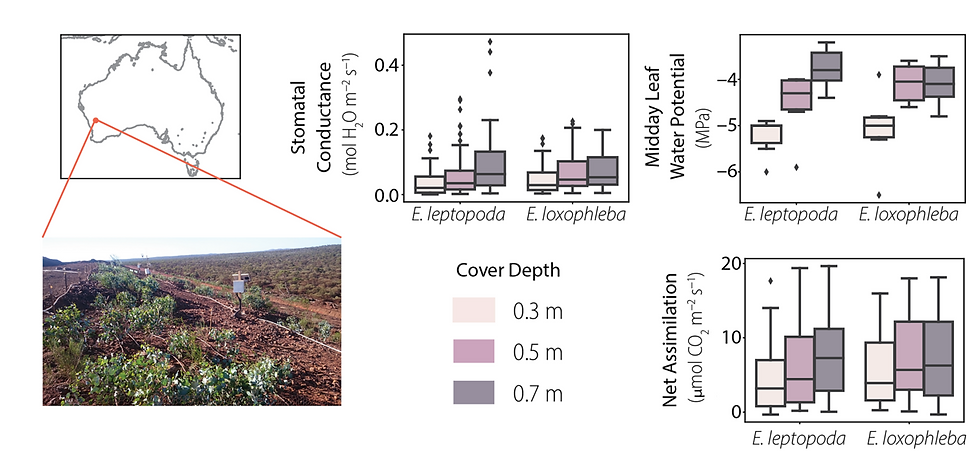Ecophysiology for rehabilitation
- sallythompson5
- Sep 1
- 4 min read
Waste. Until we nail the circular economy, we will need to manage it. A typical strategy for many kinds of waste - whether urban waste in landfills, or mining spoil in waste dumps - is to stabilise and immobilise it. Preventing water from reaching the waste is an important part of immobilisation, because water can transport contaminants from the waste site to the neighbouring environment.
Soil evapotranspiration covers are an emerging way to prevent water reaching waste layers. Waste is covered by vegetated soil, so that plants to remove water from the soil by evapotranspiration, preventing leakage into the waste layers. Evapotranspiration covers can restore biodiversity, sequester carbon and create new recreational landscapes. Vegetating landfill covers can even reduce methane emissions, by promoting the establishment of soil methanotrophic bacteria. But of course - the covers have to work!

A (simple) vegetated soil cover installed on an urban landfill in Florida.
Soil cover performance relies on 3 things - the properties of the soil, the depth of the cover, and the plant. In mining rehabilitation, rehabilitation often needs to make use of locally stockpiled topsoil or overburden, and plants must reflect the local ecosystem. This means that the depth of the cover layer is often the main design choice that can be made.
Plant physiology friends Sebastian Lamoureux and Erik Veneklaas were looking at exactly this question and found that the depth of the cover layer influenced the physiological responses of the plants that grew. Trees of the same species that grew in shallower covers had lower stomatal conductance, lower transpiration rates, and lower rates of net photosynthesis, as well as more negative leaf water potentials (indicating higher levels of stress) than trees in deeper soils. What did this mean for designing evapotranspiration waste covers and their performance?

To answer this question, the always game Jeannie Wilkening used a plant hydraulics model that could draw on Sebastian and Erik's data and explore the consequences for cover performance.

Wherever possible, the model parameters were prescribed based on the measurements made in the field. For the parameters that weren't measured, we calibrated the model to the transpiration and photosynthesis measurements that were made in the field.
It is difficult to adequately constrain lots of model parameters with a relatively small amount of data - and we had to find the values for 17 parameters. To cope with the uncertainty that this causes, we ran the model with ~150 parameter combinations for each species that produced similarly good calibration behaviour. This captures some of the uncertainty caused by the difficulty in pinpointing the model parameters from the observed data.
With these parameter ensembles, the hydraulic model could be run for historical rainfall under different cover depths and the outcomes - those related to plant survival and those related to leakage through the waste cover - evaluated. Given the many years of data and the multiple model parameters, the results are best understood as a "risk" of different outcomes taking place.

For example, across the parameter sets and a ~18 month model run period, the plots below show that there was mostly no leakage, mostly the plants lost a lot of conductance during stress periods, and that they differed from each other most in carbon uptake - while the best performance of the cover and the plants was associated with a deeper cover depth.

Across all the simulations, it was clear that deeper covers produced the best results in terms of leakage reduction, plant stress and carbon fixation. This is shown below in so-called exceedance plots. The larger the value on the x axis, the more likely it is that the value on the y axis will be exceeded. So we can see that the risk of leakage approximately halves between a cover depth of 0.3 and 0.7 m, the risks of plant stress drop substantially as well - e.g. the likelihood of losing 50% of conductance drops from 100% to 70%, and the likelihood of significant carbon uptake increases.

While the implications of the study broadly were that (i) the species choice was not a significant driver of predicted plant outcomes, and (ii) cover depth was an important and sensitive choice, more broadly we believe the study suggests a role for plant hydraulic modeling in design of evaporation covers. Jeannie summarised this in a nice flow chart which translates the typical engineering design process into this domain. Understanding plant hydraulic traits and combining them with other cover design choices allows different options to be assessed prior to implementation, and offers opportunities to maximise the benefits and reduce the risks of evapotranspiration covers.





Comments